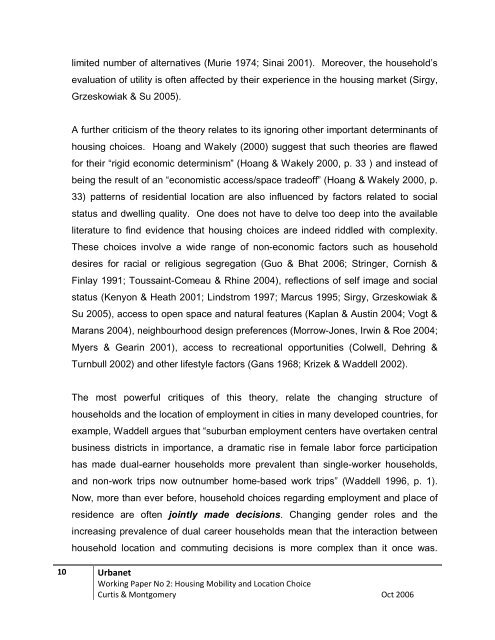Housing Mobility and Location Choice - Urbanet - Curtin University
Housing Mobility and Location Choice - Urbanet - Curtin University
Housing Mobility and Location Choice - Urbanet - Curtin University
You also want an ePaper? Increase the reach of your titles
YUMPU automatically turns print PDFs into web optimized ePapers that Google loves.
limited number of alternatives (Murie 1974; Sinai 2001). Moreover, the household’s<br />
evaluation of utility is often affected by their experience in the housing market (Sirgy,<br />
Grzeskowiak & Su 2005).<br />
A further criticism of the theory relates to its ignoring other important determinants of<br />
housing choices. Hoang <strong>and</strong> Wakely (2000) suggest that such theories are flawed<br />
for their “rigid economic determinism” (Hoang & Wakely 2000, p. 33 ) <strong>and</strong> instead of<br />
being the result of an “economistic access/space tradeoff” (Hoang & Wakely 2000, p.<br />
33) patterns of residential location are also influenced by factors related to social<br />
status <strong>and</strong> dwelling quality. One does not have to delve too deep into the available<br />
literature to find evidence that housing choices are indeed riddled with complexity.<br />
These choices involve a wide range of non-economic factors such as household<br />
desires for racial or religious segregation (Guo & Bhat 2006; Stringer, Cornish &<br />
Finlay 1991; Toussaint-Comeau & Rhine 2004), reflections of self image <strong>and</strong> social<br />
status (Kenyon & Heath 2001; Lindstrom 1997; Marcus 1995; Sirgy, Grzeskowiak &<br />
Su 2005), access to open space <strong>and</strong> natural features (Kaplan & Austin 2004; Vogt &<br />
Marans 2004), neighbourhood design preferences (Morrow-Jones, Irwin & Roe 2004;<br />
Myers & Gearin 2001), access to recreational opportunities (Colwell, Dehring &<br />
Turnbull 2002) <strong>and</strong> other lifestyle factors (Gans 1968; Krizek & Waddell 2002).<br />
The most powerful critiques of this theory, relate the changing structure of<br />
households <strong>and</strong> the location of employment in cities in many developed countries, for<br />
example, Waddell argues that “suburban employment centers have overtaken central<br />
business districts in importance, a dramatic rise in female labor force participation<br />
has made dual-earner households more prevalent than single-worker households,<br />
<strong>and</strong> non-work trips now outnumber home-based work trips” (Waddell 1996, p. 1).<br />
Now, more than ever before, household choices regarding employment <strong>and</strong> place of<br />
residence are often jointly made decisions. Changing gender roles <strong>and</strong> the<br />
increasing prevalence of dual career households mean that the interaction between<br />
household location <strong>and</strong> commuting decisions is more complex than it once was.<br />
10 <strong>Urbanet</strong><br />
Working Paper No 2: <strong>Housing</strong> <strong>Mobility</strong> <strong>and</strong> <strong>Location</strong> <strong>Choice</strong><br />
Curtis & Montgomery Oct 2006


